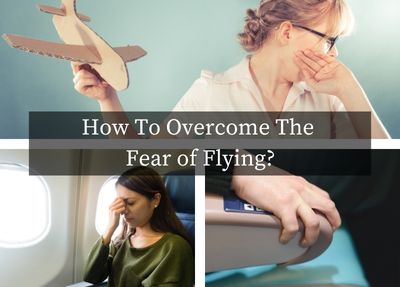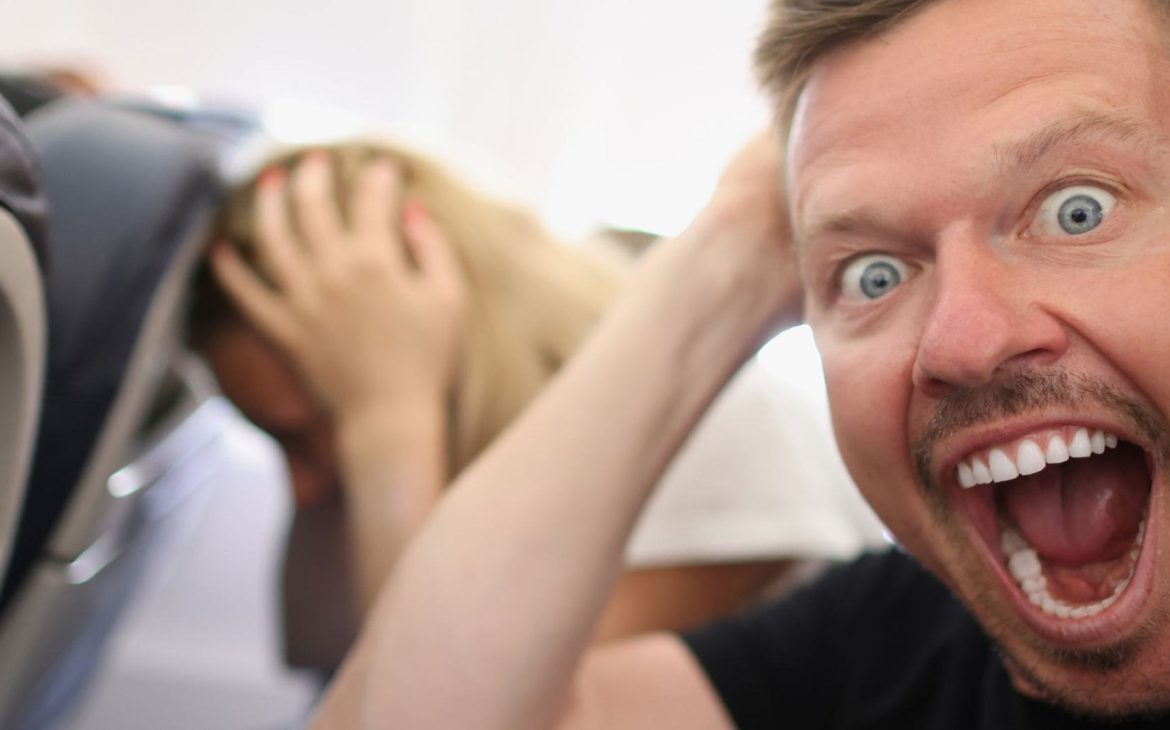Ultimate Guide: How to overcome the Fear of Flying?

Introduction
Fear of Flying, also known as aviophobia, affects a significant number of individuals worldwide. This intense fear can create anxiety and distress, preventing people from enjoying the remarkable experience of air travel.
In this post, we will delve into the prevalence of the Fear of Flying and its impact on individuals. Our primary goal is to provide you with a comprehensive step-by-step guide that will empower you to overcome your fear and embark on fear-free travel adventures.
In this blog post, Travelworld22 , Cover How to overcome the Fear of Flying?
1. Understanding the Fear of Flying
The Fear of Flying, commonly known as aviophobia, affects a significant number of individuals and can hinder their ability to enjoy air travel. In this section, we will delve into the definition and description of the Fear of Flying fear of flying, explore its common triggers and symptoms, and emphasize the significance of understanding this fear and its underlying causes.
The Fear of Flying is a common phobia that can manifest in various ways, including heightened anxiety, panic attacks, and avoidance behavior. This fear often stems from a combination of factors, such as a fear of heights, a lack of control, and concerns about safety.
Flight anxiety can impact individuals of all backgrounds, from first-time flyers to frequent travelers. By understanding the root causes and triggers of this fear, we can begin to address and overcome it.
A. Defining and Describing the Fear of Flying:
The Fear of Flying, or aviophobia, refers to an intense fear or anxiety specifically related to flying in airplanes. It is a specific phobia that falls under the broader category of anxiety disorders. Aviophobia can manifest in various ways, ranging from mild uneasiness and discomfort to severe panic attacks.
It can be characterized by anticipatory anxiety before a flight, fear of crashing or losing control, or a general sense of unease associated with being in an airplane.
B. Common Triggers and Symptoms of Flight Anxiety:
Flight anxiety can be triggered by a combination of factors, including but not limited to:
- Fear of heights: The sensation of being high above the ground can trigger anxiety in individuals with a fear of heights, intensifying their Fear of Flying.
- Lack of control: Many people experience anxiety when they perceive a lack of control over their environment or the outcome of a situation. Flying in an airplane can evoke this sense of helplessness.
- Turbulence and safety concerns: Turbulence and other in-flight movements can cause heightened anxiety, as individuals may associate them with potential danger.
- Previous traumatic experiences: Individuals who have experienced traumatic events related to flying, such as accidents or severe turbulence, may develop a Fear of Flying due to the emotional impact of those experiences.
Common symptoms experienced by individuals with Flight anxiety include increased heart rate, shortness of breath, sweating, trembling, nausea, and a strong desire to escape or avoid flying altogether.
C. The Importance of Understanding the Fear and Its Underlying Causes:
Understanding the Fear of Flying is crucial for several reasons. Firstly, it allows individuals to recognize and acknowledge their anxiety, validating their experiences and reducing the stigma surrounding Flight anxiety.
By understanding the triggers and symptoms, individuals can develop effective coping strategies and seek appropriate support. Additionally, exploring the underlying causes of the Fear of Flying can help individuals gain insights into their own fears, enabling them to address and challenge them directly.
By understanding the fear and its underlying causes, individuals can embark on a journey of self-discovery and growth. This knowledge empowers them to take proactive steps towards overcoming their fear and regaining control over their flying experiences.
Through education, support, and personal reflection, it is possible to transform fear into a sense of empowerment and enjoy the wonders of air travel.
However, Understanding the Fear of Flying, its definition, common triggers, and associated symptoms, is crucial for individuals seeking to overcome Flight anxiety. By gaining insights into the nature of aviophobia and acknowledging the specific challenges it presents, individuals can embark on a path towards conquering their fear and reclaiming the joy of flying.
In the next sections, we will explore practical strategies and techniques to help individuals overcome their fear and embrace fear-free travel experiences.

2. Preparation and Education
Preparation is key to tackling Flight anxiety. By gathering relevant information about the flight process, aircraft, and safety procedures, you can alleviate some of the uncertainties that contribute to fear. Research airlines with excellent safety records, review flight statistics, and familiarize yourself with the common sounds and sensations experienced during flights.
Educate yourself about the aviation industry, flight regulations, and the rigorous training pilots undergo. Equipping yourself with knowledge can help demystify the flying experience and instill a sense of confidence.
When it comes to overcoming the Fear of Flying, being well-prepared and educated plays a crucial role in easing anxiety and instilling confidence.
In this section, we will explore the significance of preparation, provide valuable tips on gathering essential information about the flight process, aircraft, and safety procedures, and recommend resources to enhance your knowledge about aviation and flight safety.
A. The Significance of Being Well-Prepared for a Flight:
Being well-prepared for a flight can alleviate anxiety and provide a sense of control over the unknown. When individuals have a clear understanding of what to expect during their journey, they can proactively address their concerns and mitigate their fears.
Preparation enables you to anticipate and navigate potential challenges, creating a smoother and more comfortable flight experience.
B. Tips for Gathering Information about the Flight Process, Aircraft, and Safety Procedures:
- Research the flight process: Familiarize yourself with the step-by-step process of flying, from check-in to boarding, and from takeoff to landing. Understand the sequence of events and the general timeline to reduce uncertainty.
- Learn about aircraft: Explore different types of aircraft used in commercial flights and understand their safety features. Research the impeccable safety records of airlines and the rigorous maintenance standards they adhere to.
- Familiarize yourself with safety procedures: Study safety procedures demonstrated by flight attendants, such as the use of seatbelts, oxygen masks, and emergency exits. Knowing these procedures in advance will help you feel more prepared and in control during the flight.
- Understand turbulence: Educate yourself about turbulence, a common source of anxiety for many fearful flyers. Learn that turbulence is a normal part of flying and understand how pilots and aircraft are designed to withstand it safely.
- Explore aviation terminology: Familiarize yourself with basic aviation terminology to better understand announcements made during the flight. Understanding the language used by pilots and crew members can help demystify the experience.
C. Recommendations for Educational Resources:
- Books: “Cockpit Confidential” by Patrick Smith, “Soar: The Breakthrough Treatment for Fear of Flying” by Tom Bunn, and “Flying without Fear” by Duane Brown are excellent books that provide insights into aviation, flight safety, and strategies for overcoming the Fear of Flying.
- Documentaries: Watch aviation documentaries like “Living in the Age of Airplanes” and “Fear of Flying: Caught on Camera” to gain a deeper understanding of the aviation industry, flight operations, and safety measures.
- Online courses: Explore online courses specifically designed to help individuals overcome the Fear of Flying. These courses often provide comprehensive education on aviation, flight safety, and techniques for managing anxiety during flights.

By actively seeking knowledge and understanding about the flight process, aircraft, and safety procedures, you can empower yourself to face your fears head-on. Education equips you with the necessary information to challenge misconceptions and replace anxiety with confidence.
However, Preparation and education are key elements in combating the Fear of Flying. By investing time in gathering information, understanding the flight process, familiarizing yourself with aircraft and safety procedures, and exploring educational resources, you can significantly reduce anxiety and gain a sense of control.
In the next section, we will delve into relaxation techniques and mindset strategies that further contribute to conquering the Fear of Flying, ensuring a more enjoyable and fear-free travel experience.
3. Relaxation Techniques and Mindset
Managing anxiety during flights requires cultivating relaxation techniques and fostering a positive mindset. Deep breathing exercises, progressive muscle relaxation, and mindfulness meditation can help reduce stress and induce calmness.
Embrace positive affirmations, visualize smooth and pleasant flights, and challenge negative thoughts associated with flying. By actively shifting your mindset and focusing on relaxation, you can rewire your brain’s response to the Fear of Flying.
When it comes to conquering the Fear of Flying, relaxation techniques and a positive mindset can work wonders in alleviating anxiety and promoting a sense of calm. In this section, we will explore effective relaxation techniques such as deep breathing exercises, progressive muscle relaxation, and meditation.
We will also delve into the benefits of positive affirmations, visualization, and cultivating a positive mindset to reframe negative thoughts associated with flying.
A. Introducing Relaxation Techniques:
- Deep breathing exercises: Deep breathing is a powerful relaxation technique that helps calm the body and mind. Practice slow, deep breaths, inhaling deeply through your nose, and exhaling gently through your mouth. Focus on the sensation of your breath as it enters and leaves your body, allowing it to anchor you in the present moment.
- Progressive muscle relaxation: This technique involves systematically tensing and relaxing different muscle groups to release tension and promote relaxation. Starting from your toes, gradually work your way up through your body, tensing and then releasing each muscle group, consciously letting go of any tension you may be holding.
- Meditation: Incorporating meditation into your daily routine can have profound effects on anxiety reduction. Find a quiet space, close your eyes, and focus your attention on your breath or a calming visualization. Allow your thoughts to come and go without judgment, cultivating a sense of inner peace and tranquility.
B. Benefits of Positive Affirmations and Visualization:
- Positive affirmations: Repeat positive statements to yourself, such as “I am safe and calm during flights,” or “I trust in the competence of the pilots and crew.” These affirmations help shift your mindset from fear to confidence and reinforce positive beliefs about flying.
- Visualization: Use the power of visualization to create positive and calming mental imagery. Picture yourself boarding the plane with ease, feeling relaxed and enjoying a smooth flight. Visualize a successful and anxiety-free travel experience, allowing your mind to embrace positive outcomes.
C. Cultivating a Positive Mindset and Reframing Negative Thoughts:
- Challenge negative thoughts: Recognise and address any negative beliefs you may have about flying. Substitute them with logical and constructive options. Consider reframing the question as, “What if the plane crashes?” as, “Flying is statistically one of the safest modes of transportation, and accidents are extremely rare.”
- Focus on the present moment: Focus on the here and now rather than worrying about unknown future events. Take note of the sights, sounds, and sensations surrounding you to activate your senses. Keeping your focus on the here and now can help you feel less anxious about potential flying hazards.
- Seek support: Embrace a network of friends, family, or other afraid flyers who will support you. Have frank discussions about your fears, voice your worries, and look for comfort. Getting involved in online forums or support groups for those who are struggling with flying anxiety can also be a great way to get understanding and support.
You may effectively manage anxiety and turn your Fear of Flying into a renewed sense of exhilaration and confidence by implementing relaxation techniques, practising positive mantras and visualisation, and developing a positive mentality.
Conclusion
The Fear of Flying should not limit your travel experiences or prevent you from exploring the world. By understanding the prevalence and impact of the Fear of Flying, preparing and educating yourself, implementing relaxation techniques, gradually exposing yourself to flight-related stimuli, seeking professional help, and utilizing coping strategies, you can overcome your fear and embark on fear-free travel adventures.
Also Read : Discover the Ultimate Balinese Escape: The Best Villas in Bali




Comments
Trackbacks & Pingbacks
[…] this Ultimate guide we will explore the Best Places to Visit in Summer. Summer is a season of sunshine, fun, and adventure, and there’s no better way to enjoy it […]
[…] To Read How to overcome the Fear of Flying : A Step-by-Step Guide – Click Here […]
[…] Also Read : How to overcome the Fear of Flying : A Step-by-Step Guide to Fear-Free Travel […]
[…] this Ultimate guide we will explore the Best Places to Visit in Summer. Summer is a season of sunshine, fun, and adventure, and there's no better way to enjoy it than by […]